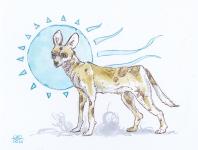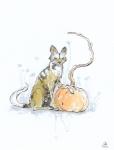Galleries : Undying Tales 2021 : UT 10 - Painted Wolf
|
Lycaon pictus Status: Endangered - habitat fragmentation and infectious disease. The oldest breed of canines is the painted lycaon. They stalk through the savannahs of Africa in highly social and familial packs, hunting antelope, and have lived alongside humans for thousands of years but remains undomesticated, avoiding human contact. In Egypt`s Predynastic period, lycaon were found engraved and carved on objects and jewelry. By contrast, in later Ancient Egypt imagery, domesticated dogs and wild wolves were instead depicted. It is thought that the lycaon imagery symbolized the chaos of the wild, that later was replaced by the tamed and domesticated canine partners of humanity. In Enno Littman’s Publications of the Princeton Expedition to Abyssinia he recounts a tale “Of the Debbi”. The debbi is described as a wild animal, smaller than a dog, and the story he relates is of a man who goes down to a river to fetch water. Before he reached the river, he noticed a great number of animals gathered around, drinking. Suddenly, the debbi approached, and there was a wild scrambling as all the animals, great and small, fled, leaving the debbi to drink alone, and eventually leave. The man was puzzled by this, and when he wandered down to the river at last, he found a hair of the debbi, which he tucked into his cloak. When he returned to his village, just as the animals had fled from the debbi, his fellow men and women fled from him, and he was frightened and puzzled. At last, a brave man purchased the strange hair from him and created a talisman of it. It is said that when a man is a great warrior whose enemies fear him, that “he must have the hair of a debbi about him.” Source:
Size: 7 x 7 inches Detail closeups:
|




